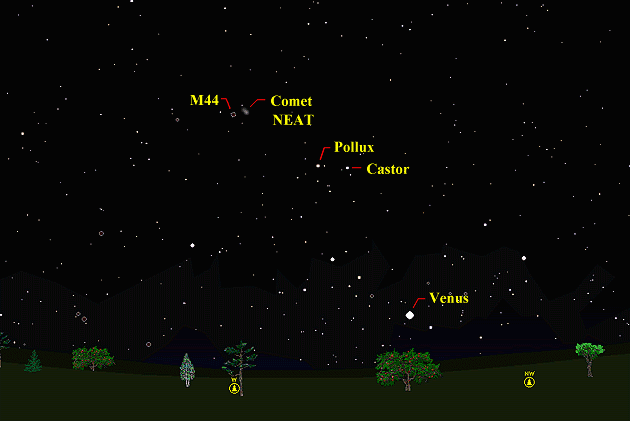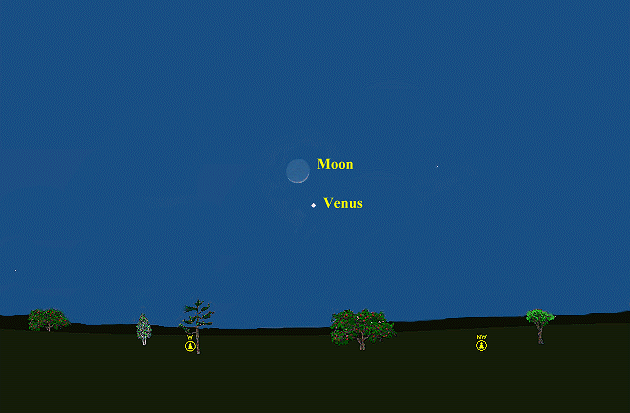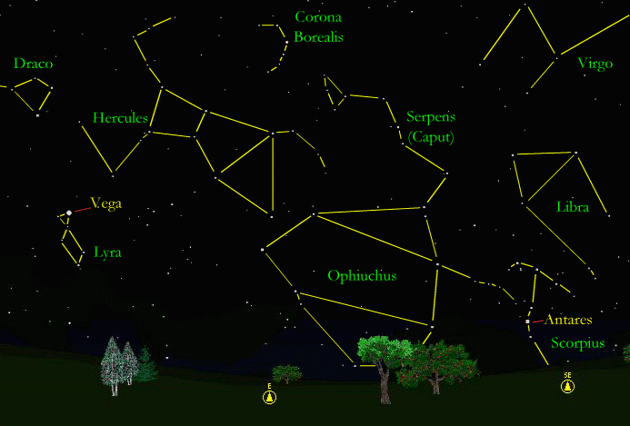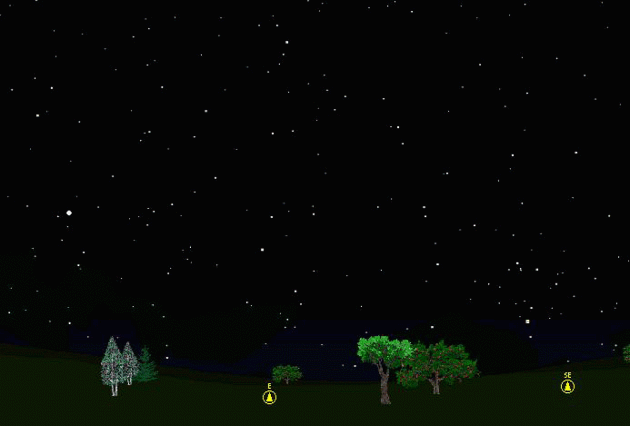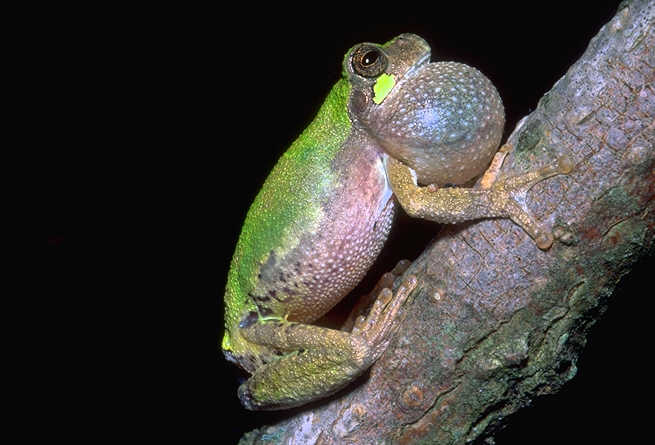The purpose of this feature is to give scout leaders, educators and naturalists an idea of some of the natural events coming up each month. We will try to cover a variety of natural events ranging from sky events to calling periods of amphibians, bird and mammal watching tips, prominent wildflowers and anything else that comes to mind. We will also note prominent constellations appearing over the eastern horizon at mid-evening each month for our area for those who would like to learn the constellations. If you have suggestions for other types of natural information you would like to see added to this calendar, let us know! Note: You can click on the hyperlinks to learn more about some of the featured items. To return to the Calendar, hit the "back" button on your browser, NOT the "back" button on the web page. Sky Events: How NEAT is this! Two comets, Comet NEAT and Comet LINEAR, grace our skies this month. Comet NEAT appears to be the easiest one to observe, and will appear around May 5th in the evening sky after sunset just south of the bright star Sirius. The comet climbs higher above the horizon each night, its path roughly paralleling a line from Sirius to Procyon. Use binoculars to help find it (only after the sun has gone down, you can quickly and permanently damage your eyes if you view the sun with binoculars). Your view of the comets will be much better if you take the time to drive to a location far from city lights. Otherwise, light pollution will rob you of a good view. For a complete description of the positions and brightness of both comets, click on the link below: http://skyandtelescope.com/observing/objects/comets/article_1229_1.asp The view below shows Comet NEAT on the evening of May 15, when it passes the "Beehive Cluster" , M44, in Cancer. The view should be stunning from a dark sky location. Look for the comet about 13 degrees above and to the left of the bright star Pollux in Gemini. Again, bring your binoculars.
Evening Sky: Venus, Mars, Jupiter and Saturn all continue to be visible in the evening sky in May. Venus will outshine all of the other planets in evening sky, and this month you can watch it swing between the earth and the sun. As it draws nearer to the earth, it becomes a very large, very slim crescent that is quite beautiful to view. Its apparent diameter becomes so large that you can actually see a tiny crescent in any pair of good quality binoculars. One small secret; to see the crescent well in binoculars you must spot it as early in the evening as possible, while the sky is still pretty bright. When the sky darkens the bright image will dazzle your eye (and bring out all of the faults in your binoculars) and the crescent won't be visible. This binocular view of the tiny crescent Venus against a twilight sky is one of my favorite views. The view below is for May 15th, when the crescent moon is near Venus. Since both the moon and Venus are in about the same direction from earth, you will see that the both have about the same phase (ie. thin crescents facing the same direction). You might want to visualize the two in space, the moon only about a 1/4 of a million miles away and Venus much, much farther away at about 34 million miles. Venus is about the same diameter as the earth, so if you were orbiting Venus and looked back at the earth, it would appear about the same size as your binocular image. See if you can visualize what phase the earth would appear. As the apparent distance from Venus to the Sun shrinks as the month goes on, Venus continues to grow in size and the crescent gets even thinner. A look with binoculars at twilight, perhaps with some clouds drifting by, is unforgettable.
Morning Sky: Mercury reaches its greatest elongation from the sun on May 14th, but it will appear very low in the eastern sky about 45 minutes before sunrise. All times noted in the Sky Events are for Franklin, Tennessee and are Central Daylight Time. These times should be pretty close anywhere in the mid-state area. Constellations: The views below show the sky looking east at 9:30pm CDT on May 20th. The first view shows the sky with the constellation outlined and names depicted. Star and planet names are in yellow. Constellation names are in green. The second view shows the same scene without labels. New constellations this month in the eastern sky are Lyra, the Lyre, with it's bright star Vega, and Ophiuchus, the Serpent Bearer, Libra, the Scales, and the head and upper body of Scorpius, the Scorpion. Look in the southeast for Scorpius and it's bright red star Antares.
On Learning the Constellations: We advise learning a few constellations each month, and then following them through the seasons. Once you associate a particular constellation coming over the eastern horizon at a certain time of year, you may start thinking about it like an old friend, looking forward to its arrival each season. The stars in the evening scene above, for instance, will always be in the same place relative to the horizon at the same time and date each May. Of course, the planets do move slowly through the constellations, but with practice you will learn to identify them from their appearance. In particular, learn the brightest stars (Like Antares and Vega in the above scene looking east), for they will guide you to the fainter stars. Once you can locate the more prominent constellations, you can "branch out" to other constellations around them. It may take you a little while to get a sense of scale, to translate what you see on the computer screen or what you see on the page of a book to what you see in the sky. Look for patterns, like the stars that make up the constellation Hercules. The earth's rotation causes the constellations to appear to move across the sky just as the sun and the moon appear to do. If you go outside earlier than the time shown on the charts, the constellations will be lower to the eastern horizon. If you observe later, they will have climbed higher. As each season progresses, the earth's motion around the sun causes the constellations to appear a little farther towards the west each night for any given time of night. If you want to see where the constellations in the above figures will be on June 15th at 9:00pm CDT, you can stay up till 11:00pm CDT on May 15th and get a preview. The westward motion of the constellations is equivalent to two hours per month. A good book to learn the constellations is H. A. Rey's classic, The Stars, A New Way to See Them. Rey's depictions of the constellations and witty commentary are terrific. A good general reference book on astronomy is the Peterson Field Guide, A Field Guide to the Stars and Planets, by Pasachoff. The book retails for around $14.00. A good beginners software program for learning the night sky is the Starry Night Beginner program. Visit the Starry Night web site at www.starrynight.com The program retails for around $30.00 and contains a wealth of information.
Amphibians:
By the end of May all of Tennessee's Frogs and Toads are either calling or have already reached their peak calling period and are being heard less. The treefrogs are the last of our frogs and toads to start calling. Cope's Gray Treefrog and Gray Treefrogs start giving isolated calls as early as March, and by the end of this month listen also for Bird-Voiced Treefrogs, Green Treefrogs and Barking Treefrogs. In May we also hear Fowler's Toads calling frequently, so listen for their "crying baby" call. Northern Cricket Frogs are hitting their stride as well. Listen for a sound like two stones being tapped together. We have heard eight or more species of frogs calling on some May evenings, so it's a great time to listen. Upland Chorus Frogs and Spring Peepers continue to call. Listen for their calls to increase in pitch and quicken with the rising temperatures.
Birds: Try to get out with a pair of binoculars in the early morning in the first two weeks of May to take full advantage of the spring migration. The later nesting owls like Eastern Screech Owls are nesting right now. In late May and early June, the young screech owls can sometimes be heard giving their raspy "begging" calls. Easier to hear is a sound that the adult owls make around the young owls, a downward slurred whistle about a half second in duration. This call sounds more like a puppy whimpering than an owl, but you can sometimes follow the sound and come upon a whole group of young screech owls on a tree limb. Recommended: Bird Finding in Tennessee, Michael Lee Bierly. A classic guide to finding birds in Tennessee. The Sibley Guide to Birds, David Allen Sibley The Sibley Guide to Birds of Eastern North America, David Allen Sibley This new Sibley Guide covers only eastern North America, is quite compact, and is less expensive than the larger Sibley. An inexpensive guide for beginners is the Golden Guide for Birds.
Wildflowers: Some of favorite Spring wildflower walks are: The south ridge at the Owl's Hill Nature Center in Brentwood, Tennessee. The Edwin Warner paved loop at the Warner Parks in Nashville or just about any trail in Warner Parks. The greenway at Ashland City, Tennessee. The Angel Falls trail along the Cumberland River at the Big South Fork Recreational Area, near Jamestown, Tennessee.
Archives (Remember to use the back button on your browser, NOT the back button on the web page!)
Natural Calendar
February 2004
Natural Calendar
December 2003
Natural Calendar
November 2003
Natural Calendar
September 2003 Natural Calendar February 2003 Natural Calendar December 2002 Natural Calendar November 2002 Nature Notes Archives: Nature Notes was a page we published in 2001 and 2002 containing our observations about everything from the northern lights display of November 2001 to frog and salamander egg masses. Night scenes prepared with Starry Night Pro software, All other images copyright 2004 LEAPS
|
